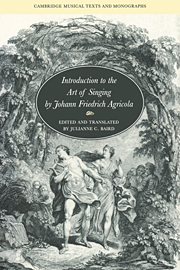Book contents
- Frontmatter
- Contents
- Acknowledgments
- Introduction: Agricola's treatise
- INTRODUCTION TO THE ART OF SINGING
- Translator's preface
- Foreword of the author
- Introduction of the author
- 1 Observations for the use of the singing teacher
- 2 Concerning appoggiaturas
- 3 Concerning trills
- 4 Concerning divisions
- 5 Concerning recitative
- 6 Remarks intended especially for the music student
- 7 Concerning arias
- 8 Concerning cadenzas
- 9 Remarks for the use of the professional singer
- 10 Concerning improvised variations of melodies
- Notes
- Bibliography
- Index
7 - Concerning arias
Published online by Cambridge University Press: 10 December 2009
- Frontmatter
- Contents
- Acknowledgments
- Introduction: Agricola's treatise
- INTRODUCTION TO THE ART OF SINGING
- Translator's preface
- Foreword of the author
- Introduction of the author
- 1 Observations for the use of the singing teacher
- 2 Concerning appoggiaturas
- 3 Concerning trills
- 4 Concerning divisions
- 5 Concerning recitative
- 6 Remarks intended especially for the music student
- 7 Concerning arias
- 8 Concerning cadenzas
- 9 Remarks for the use of the professional singer
- 10 Concerning improvised variations of melodies
- Notes
- Bibliography
- Index
Summary
1. If the person who introduced the practice of repeating an aria from the beginning intended to give the singers an opportunity to show their skill in varying the phrases already performed, the music lover cannot find fault with this invention; nevertheless, a great part of the expression of the words is lost thereby(a).
(a) This is chiefly a matter of an able and musically inclined poet's so arranging the arias that they can be repeated from the beginning without prejudicing the sense and the power of the words. Through the repetition from the beginning a new emphasis is perhaps achieved. In crafting the poems to be set to music, if the poet bears in mind that he wants to express thoughts and feelings, not for themselves alone, but in close unity and liaison with the music, he will not find it difficult to sacrifice, if necessary, a few poetic embellishments in the arias and choruses, which, after all, consist of only a few lines. Besides, the music allows him a free hand in the more expansive recitatives, forbidding him little or nothing except a few quite inappropriate verse forms. If Italian librettists of Tosi's time have been culpable, the blame for this must not be placed on the music. But have not some contemporary Germans proven through rules and practice that poetic and musical beauties do not necessarily neutralize each other?
2. Arias were sung in three different styles by our famous Ancients.
- Type
- Chapter
- Information
- Introduction to the Art of Singing by Johann Friedrich Agricola , pp. 188 - 203Publisher: Cambridge University PressPrint publication year: 1995



